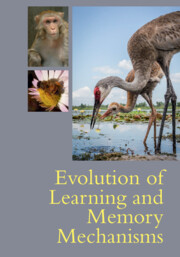24 results
19 - A Requiem for Ape Language Research
-
-
- Book:
- Primate Cognitive Studies
- Published online:
- 28 July 2022
- Print publication:
- 11 August 2022, pp 483-504
-
- Chapter
- Export citation
Part II - Evolution of Memory Processes
-
- Book:
- Evolution of Learning and Memory Mechanisms
- Published online:
- 26 May 2022
- Print publication:
- 19 May 2022, pp 283-472
-
- Chapter
- Export citation
Contributors
-
- Book:
- Evolution of Learning and Memory Mechanisms
- Published online:
- 26 May 2022
- Print publication:
- 19 May 2022, pp xv-xviii
-
- Chapter
- Export citation
7 - Pavlovian Conditioning, Survival, and Reproductive Success
- from Part I - Evolution of Learning Processes
-
-
- Book:
- Evolution of Learning and Memory Mechanisms
- Published online:
- 26 May 2022
- Print publication:
- 19 May 2022, pp 125-142
-
- Chapter
- Export citation
Introduction
-
-
- Book:
- Evolution of Learning and Memory Mechanisms
- Published online:
- 26 May 2022
- Print publication:
- 19 May 2022, pp 1-12
-
- Chapter
- Export citation
Index
-
- Book:
- Evolution of Learning and Memory Mechanisms
- Published online:
- 26 May 2022
- Print publication:
- 19 May 2022, pp 473-500
-
- Chapter
- Export citation
Preface
-
- Book:
- Evolution of Learning and Memory Mechanisms
- Published online:
- 26 May 2022
- Print publication:
- 19 May 2022, pp xix-xx
-
- Chapter
- Export citation
Copyright page
-
- Book:
- Evolution of Learning and Memory Mechanisms
- Published online:
- 26 May 2022
- Print publication:
- 19 May 2022, pp iv-iv
-
- Chapter
- Export citation
Tables
-
- Book:
- Evolution of Learning and Memory Mechanisms
- Published online:
- 26 May 2022
- Print publication:
- 19 May 2022, pp xiii-xiv
-
- Chapter
- Export citation

Evolution of Learning and Memory Mechanisms
-
- Published online:
- 26 May 2022
- Print publication:
- 19 May 2022
Part I - Evolution of Learning Processes
-
- Book:
- Evolution of Learning and Memory Mechanisms
- Published online:
- 26 May 2022
- Print publication:
- 19 May 2022, pp 13-282
-
- Chapter
- Export citation
Contents
-
- Book:
- Evolution of Learning and Memory Mechanisms
- Published online:
- 26 May 2022
- Print publication:
- 19 May 2022, pp v-viii
-
- Chapter
- Export citation
Figures
-
- Book:
- Evolution of Learning and Memory Mechanisms
- Published online:
- 26 May 2022
- Print publication:
- 19 May 2022, pp ix-xii
-
- Chapter
- Export citation
COVID-19 and Fieldwork: Challenges and Solutions
-
- Journal:
- PS: Political Science & Politics / Volume 54 / Issue 2 / April 2021
- Published online by Cambridge University Press:
- 19 January 2021, pp. 264-269
- Print publication:
- April 2021
-
- Article
-
- You have access
- HTML
- Export citation
Observational constraints on the formation and evolution of the Milky Way nuclear star cluster with Keck and Gemini
-
- Journal:
- Proceedings of the International Astronomical Union / Volume 11 / Issue S322 / July 2016
- Published online by Cambridge University Press:
- 09 February 2017, pp. 222-230
- Print publication:
- July 2016
-
- Article
-
- You have access
- Export citation
Nosocomial Pulmonary Tuberculosis Contact Investigation in a Neonatal Intensive Care Unit
-
- Journal:
- Infection Control & Hospital Epidemiology / Volume 34 / Issue 7 / July 2013
- Published online by Cambridge University Press:
- 02 January 2015, pp. 754-756
- Print publication:
- July 2013
-
- Article
- Export citation
The science of EChO
-
- Journal:
- Proceedings of the International Astronomical Union / Volume 6 / Issue S276 / October 2010
- Published online by Cambridge University Press:
- 10 November 2011, pp. 359-370
- Print publication:
- October 2010
-
- Article
-
- You have access
- Export citation
Body size plasticity and local variation of relative head and body size sexual dimorphism in garter snakes (Thamnophis sirtalis)
-
- Journal:
- Journal of Zoology / Volume 261 / Issue 4 / December 2003
- Published online by Cambridge University Press:
- 25 November 2003, pp. 399-407
- Print publication:
- December 2003
-
- Article
- Export citation
There is more to biological behavior than causation and control
-
- Journal:
- Behavioral and Brain Sciences / Volume 24 / Issue 6 / December 2001
- Published online by Cambridge University Press:
- 17 December 2002, p. 1065
-
- Article
- Export citation
19 - Pretending culture: social and cognitive features of pretense in apes and humans
-
-
- Book:
- Pretending and Imagination in Animals and Children
- Published online:
- 13 August 2009
- Print publication:
- 21 February 2002, pp 269-279
-
- Chapter
- Export citation



